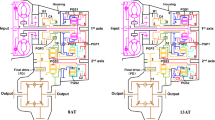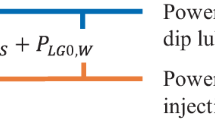Abstract
The problem of creating a wireless power transmission system for aviation technology, providing power to onboard equipment with a power of at least 30 W in accordance with the planned update of the Qi standard, is considered. A prototype of a wireless power transmission system for aviation technology, which is resistant to external influences, was made. Numerical calculations of the load capacity of the wireless power transmission system are carried out.






Similar content being viewed by others
REFERENCES
Bondarev, A.N. and Kirichek, R.V., Review of Unmanned Aerial Vehicles for General Purpose and UAV Air Traffic Control in Different Countries, Informatsionnye Tekhnologii i Telekommunikatsii, 2016, no. 4, pp. 13–23.
Ngo, K.T., Solenaya, O.Ya., and Ronzhin, A.L., Analysis of Mobile Robotic Platforms Used to Batteries Service of Unmanned Aerial Vehicles in Autonomous Missions, Trudy MAI, 2017, no. 95, URL: http://trudymai.ru/eng/published.php?ID=84444 .
Qi—Mobile Computing, Wireless Power Consortium, URL: https://www.wirelesspowerconsortium.com/qi/.
Lu, M., Bagheri, M., James, A.P., and Phung, T., Wireless Charging Techniques for UAVs: A Review, Reconceptualization, and Extension, IEEE Access, 2018, vol. 6, pp. 29865–29884.
Kai-Chi Chuang, Jih-Fu Tu, Tian-Syung Lan and Lie-Ping Zhang, The Research of Wireless Charger by Inductance of Induction Coil, Proc. of the IEEE Int. Conf. on Computation, Communication and Engineering, Nov. 8–10, 2019, Longyan, China, pp. 249–252.
Jianshu Chen, Xiulan Liu, Zhongjun Chi, Xianglong Li, Dongsheng Jiao, and Shuang Zeng, Research on Efficiency of Contactless Charging System Based on Electromagnetic Induction, Proc. of the MATEC Web of Conferences, 2016, vol. 40, article no. 07005.
Kluth, R. and Ziegner, J., Inductive Charging—Simplifying the Charge to Enable Mass Adoption, World Electric Vehicle Journal, 2012, vol. 5, pp. 714–721.
Chawla, N. and Tosunoglu, S., State of the Art in Inductive Charging for Electronic Appliances and Its Future in Transportation, Proc. of the Conference on Recent Advances in Robotics, 2012, Florida, USA, URL: https://www.researchgate.net/publication/267842615_State_of_the_Art_in_Inductive_Charging_for_Electronic_Appliances_and_its_Future_in_Transportation.
Vatsala, V., Alam, M., Ahmad, A., and Chaban, R., Efficiency Enhancement of Wireless Charging for Electric Vehicles through Reduction of Coil Misalignment, Proc. of the IEEE Transportation Electrification Conference and Expo, 2017, Chicago, USA, 10.1109/ITEC.2017.7993241.
Evstigneeva, E.I., Lekanov, A.V., Matveev, S.A., Shirshov, A.D., and Yakovenko, N.G., Development of the Wireless Control System for Shape of Large Transformed Structures Using Precision Drives, Izv. Vuz. Av. Tekhnika, 2019, vol. 62, no. 3, pp. 139–143 [Russian Aeronautics (Engl. Transl.), vol. 62, no. 3, pp. 502–507].
Matveev, S.A., Shvetsov, I.V., Shirshov, A.D., and Yakovenko, N.G., Wireless Power Supply System for Flexible Space Antenna Actuators, Izv. Vuz. Av. Tekhnika, 2018, vol. 61, no. 4, pp. 117–121 [Russian Aeronautics (Engl. Transl.), vol. 61, no. 4, pp. 636–641].
Gerashchenko, A.N., Kulikov, N.I., and Makarenko, A.V., Method of Energy Efficiency Assessment for Power Supply of Autonomous Drive Systems for Perspective Mobile Objects, Izv. Vuz. Av. Tekhnika, 2015, vol. 58, no. 4, pp. 94–98 [Russian Aeronautics (Engl. Transl.), vol. 58, no. 4, pp. 461–465].
Gerashchenko, A.N., Kulikov, N.I., Makarenko, A.V., and Sorokin, A.E., Special Operation Features of a Power Efficient Control Actuator for Promising Mobile Objects, Izv. Vuz. Av. Tekhnika, 2014, vol. 57, no. 3, pp. 3–6 [Russian Aeronautics (Engl. Transl.), vol. 57, no. 3, pp. 217–222].
Hajikhani, M., Fabrice, L., and Agba, B.L., An Autonomous Wireless Sensor Network in a Substation Area Using Wireless Transfer of Energy, IEEE Access, 2018, vol. 6, pp. 62352–62360.
Xiao Lu, Ping Wang, Dusit Niyato, and Dong In Kim, Wireless Charging Technologies: Fundamentals, Standards, and Network Applications, IEEE Communications Surveys and Tutorials, 2018, vol. 18, issue 2, pp. 1413–1452.
Kansal, A., Jason, H., Zahedi, S., and Srivastava, M.B., Power Management in Energy Harvesting Sensor Networks, ACM Transactions on Embedded Computing Systems, 2007, vol. 6, no. 4, pp. 32–44.
Cetinkaya, O. and Akan, O.B., Electric-Field Energy Harvesting in Wireless Networks, IEEE Wireless Communications, 2017, vol. 24, issue 2, pp. 34–41.
Chang, K.-S., Kang, S.-M., Park, K.-J., Shin, S.-H., Kim, H.-S., and Kim, H.-S., Electric Field Energy Harvesting Powered Wireless Sensors for Smart Grid, Journal of Electrical Engineering and Technology, 2012, vol. 7, no. 1, pp. 75–80.
Want, R., An Introduction to RFID Technology, IEEE Pervasive Computing, 2006, vol. 5, issue 1, pp. 25–33.
Huang, K. and Lau, V., Enabling Wireless Power Transfer in Cellular Networks: Architecture, Modeling and Deployment, IEEE Transactions on Wireless Communications, 2014, vol. 13, issue 2, pp. 902–912.
ACKNOWLEDGEMENTS
The R&D results presented were achieved in the framework of the project with the use of measures of state support for the development of cooperation between the Russian educational institutions of higher education, state scientific institutions and organizations implementing complex projects to create high-tech production, provided for by the Government of the Russian Federation of April 9, 2010 no. 218. “Creation of a high-tech production of components for a flexible modular sensor-communication platform for monitoring aircraft onboard systems”, Agreement no. 075-11-2019-048 of December 06, 2019 (EB 0000000007519SWQ0002).
Author information
Authors and Affiliations
Corresponding author
Additional information
Translated from Izvestiya Vysshikh Uchebnykh Zavedenii, Aviatsionnaya Tekhnika, 2021, No. 4, pp. 32 - 38.
About this article
Cite this article
Ukhov, A.A., Bulat, M.P., Volobuev, I.A. et al. Wireless Power Transmission System for Powering Onboard Equipment of an Aircraft. Russ. Aeronaut. 64, 613–619 (2021). https://doi.org/10.3103/S106879982104005X
Received:
Revised:
Accepted:
Published:
Issue Date:
DOI: https://doi.org/10.3103/S106879982104005X




